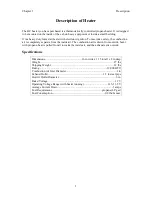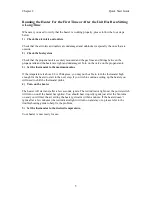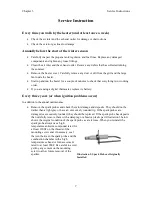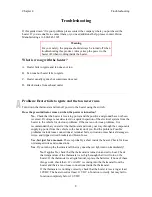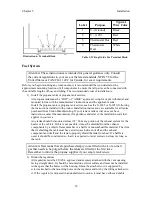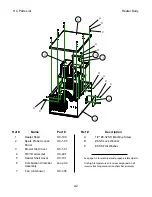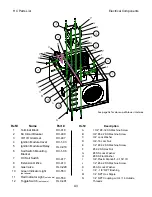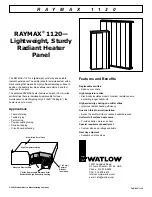
Chapter 4
Troubleshooting
gas off, double check that no spark is being produced by improving a 1/8” spark gap from
the end of the high voltage terminal to the combustion chamber. If a spark is being
produced, remove and inspect the spark probe. Check and fix any possible shorts, adjust
the spark gap to 1/8” if necessary, and reinstall the spark probe. If this does not fix the
problem refer to the troubleshooting tips at the start of this problem. If no spark is being
produced, the spark ignition module needs to be replaced.
Problem: Heater usually ignites but sometimes does not
Check that the propane tank is not low and gas is getting to the heater.
Is any extra ductwork connected to the exhaust or air inlets or outlets?
Yes
. The heater should have less than 5 feet connected to the hot air inlet and outlet . Any
additional pipe connected to the exhaust should be 1.5-inch or larger pipe less than 2 ft
long. Disconnect all ductwork to the heater to see if this corrects the problem.
No
Carefully check all the inlets and outlets and blower for debris and obstructions.
Follow the trouble shooting suggestions for problem B. In addition, use a voltmeter to
check if the heater is getting sufficient voltage while it is on. It should be 11.5 to 13.5V
for the heater to operate reliably. The heater will operate on 11 to 11.5V but poor ignition
and carbon deposits are a possibility.
Problem D: Black Smoke from Exhaust Outlet
Under normal use, the heater will produce very little, if any, black smoke near the exhaust outlet.
A white “smoke” of water vapor is normal during cold weather but darker smoke is often the first
sign of a problem with the heater and often shows up first when the vehicle powering the heater is
not running. These deposits typically indicate that one of the openings in the heater is obstructed
or the heater is not receiving enough voltage while it is running.
Check if the heater is running off of the battery only (ie the vehicle is not running). If the battery
is significantly run down or running many accessories, the heater cannot receive enough voltage
to operate properly. Running the heater for less time on the battery or starting the vehicle should
correct the problem.
If this problem occurs when the vehicle is running or after less than an hour of running on the
battery, check the following:
1) Check that none of the inlets or outlets to the heater are partially blocked or any ductwork
leading to or from the heater is damaged.
2) Check that the heater is receiving a voltage of at least 11.5 VDC at the thermostat while
the blower is running. A voltage below 11.5 VDC typically indicates a problem in the
electrical system between the heater and the vehicle. Start by looking for loose or
corroded connections.
3) Check that the regulator is producing the correct pressure of 10.5-11 inches water
column. A high pressure will cause the heater to receive too much propane.
10




